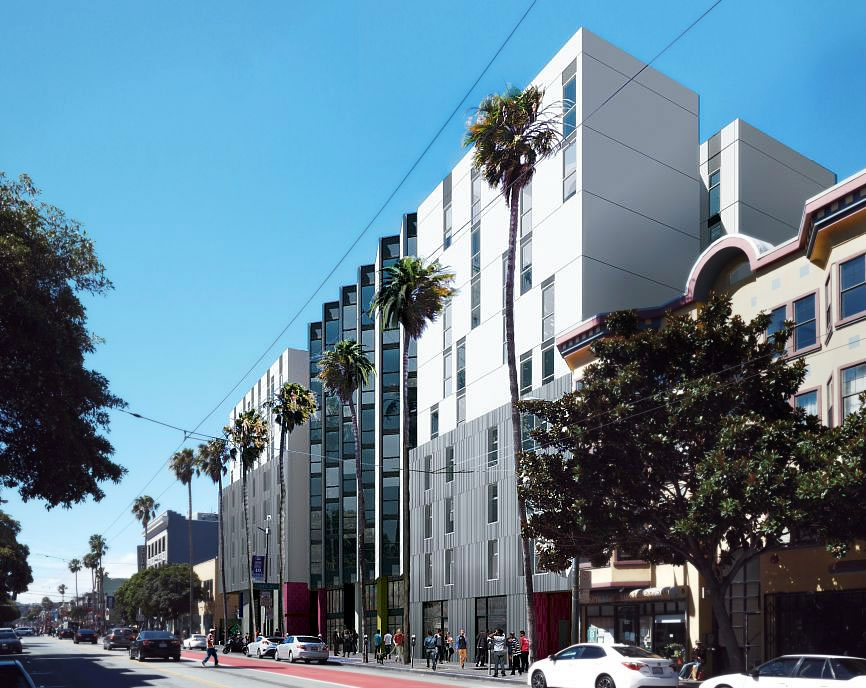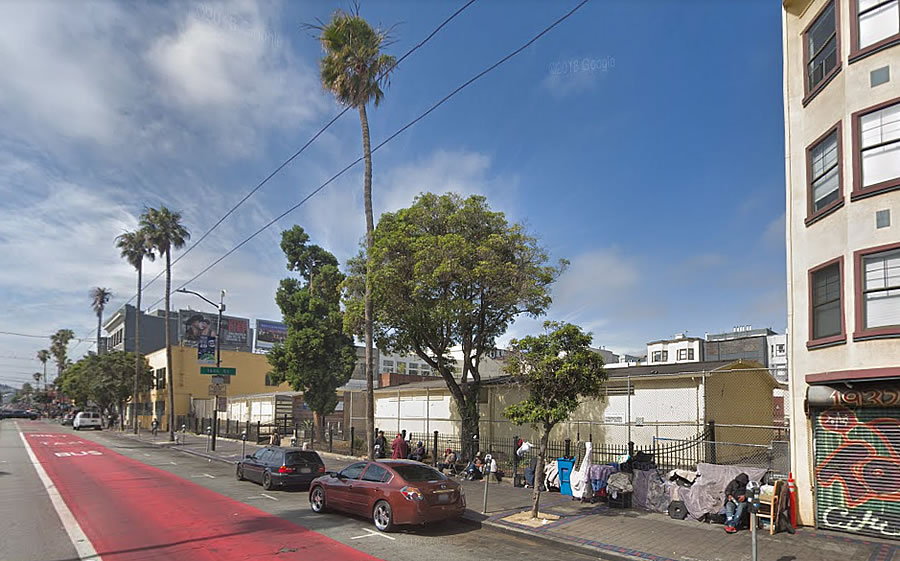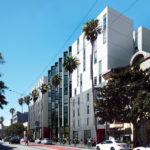The financing to build 157 below market rate (BMR) rental units upon the former Phoenix Continuation High School site turned Mission District Navigation Center at 1950 Mission Street is now expected to close sometime between mid-November and December 15.
The ground is expected to be broken within 10 days of the closing and construction is slated to be completed by December 31, 2020.
And with a total budget of $115,665,000 for the project, which will also yield a little commercial space, bike repair shop, art gallery/studio space and a child care area across the building’s ground floor, the budgeted cost to develop the 157 dwelling units – a mix of 32 studios, 36 one-bedrooms, 73 twos and 16 threes, which will be managed by BRIDGE Housing and be made available to households earning up to 60 percent of Area Median Income (AMI) – is roughly $737,000 per unit.




Exactly why, should select individuals be singled out for an exclusive limited edition, $737,000 unearned windfall?
They still pay something right? There is a seperate affordable price?
Yeah, they will be paying partial freight but not full freight. It seems unfair that these will go to a lucky few. But, is the inability to help *everybody* an acceptable reason to help nobody? I would like to see a lot more affordable housing.
If Sam Walters has a better way to provide affordable housing in the city to people with lesser incomes, let’s hear it. Or is this another thread about banishing poors to the outer rings?
Those who qualify for these units will not be poor. It will be middle class individuals. The BMR model is IMO not efficient. It is truly a lottery with very stiff odds. And the “winners” are restricted when they go to sell. Having to share a large part of the appreciation with the City. That is understandable but not, IMO, the way for middle class folks who qualify for these to go. Rather buy a rental SFH in an affordable market. Their incomes would qualify them to get loans for such. Some positive cash flow, the tax advantages and 5/10 years down the road they would be in a much better position than had they won the lottery and “bought” one of these units.
As reported above, and previously, the units will be rentals and the qualifying tenants will pay (below market rate) rents.
If they bought in a truly affordable market (I assume you are talking about non-Bay Area or even non-California) they are not likely to see nearly as much appreciation. Housing in Chicago, except for a very few favored neighborhoods, has generally lost value overall. And this is true of many “affordable” markets.
There are “truly” affordable markets set for robust appreciation due to rapid job and population growth. It takes a little research but those opportunities are out there. Chicago is not one of those markets. Look further and you can find them. All I’m saying is that, for Bay Area/SF folks wanting to get into the housing market – in the most expensive market in the country – maybe think out of the box and continue to rent here while purchasing home(s) in other much more affordable and booming, markets.
Dave, c’mon man, be real. If a household has the income to purchase a home in another, less expensive market, then they won’t have the money left over to pay (market) rent here, because if they had that kind of income, they’d have already gotten out of renting. The realistic alternative is being priced out of the area.
From Boise and Reno Capitalize on the California Real Estate Exodus:
Fun fact from the piece: In the second quarter, only 26 percent of homebuyers in California could afford to purchase a median-price single-family house, which was almost $600,000, according to the C. A. R.
Completely disagree Brahma. There are many subsets of renters in SF. For some a realistic option is to relocate to another area. For others purchasing a rental property in another metro is very doable. One group of such renters are those who rented controlled units a decade or so ago. Their rents today are significantly less than market rate. Many of these people have good jobs but are not in tech. They make in the low 100s and can’t purchase here by any stretch. But they can purchase in any number of booming markets. Ironically Boise is one such – HP has stopped most new hiring into the Bay Area in favor of cities in Texas and yes – Boise. Boise is making itself into a mini-tech hub. Meaning appreciation will be good there over time. One can find homes for 250K – 350K in Boise and many other such markets. In good neighborhoods. 20% down (50K- 75K) and an ROI of 4% – 5%. Positive cash flow. I know a number of people doing this. One has two homes out of state and they put the monthly cash flow into is expediting paying down the loans. Hoping to own both homes free and clear at the end of a decade. So yes, many renters in SF can afford to purchase rental SFHs in other markets while continuing to pay rent for their SF apartment
<60% of AMI is definitely poor
Jumbo, thank you. Some folks seem to have their idea of what “middle class” is by watching television sit-coms, or they just aren’t reading the text of the post. Let’s see if we can clarify, shall we?
If Dave takes a look at this table from The Mayor’s Office of Housing and Community Development, and scrolls down to 60% OF MEDIAN, he can confirm that for a three person household, $63,950 is the maximum income. For just a couple, it’s $56,800. Those are 2018 numbers, so of course when the project that is the subject of this post starts getting occupied, the numbers will probably be higher, but that gives you a very good idea. Even in a few years, that will not be the equivalent of “the low 100s” in 2018 dollars.
I think it would be obvious to anyone living in S.F. at any time over the past fifteen years that anyone in that income category is not middle class.
A housing subsidy tax on all City residents could be collected and then provided to City residents that qualify. Lower income residents would get more money. The recipients of the subsidy would provide their landlord’s name and address and the City would send the subsidy payment directly. The tenant would be required to pay the difference between the City subsidy and their rent. We all contribute for the common good.
“From each according to his ability; to each according to his needs.” Who said that? Oh, yeah . . . and nowhere on earth have his ideas really been successful. That would include the PRSF.
Go ahead and forfeit your eligibility for Medicare and Social Security down the line (or now).
Of course, this is a silly idea and would never be seriously proposed by any responsible policy maker because if it were actually implemented, the demand curve would shift (as a response to the increased ability to pay) and the price level of all rental units not already constrained by rent control would rise to consume the amount of the “subsidy”. So no one except the members of the penny ante, “mom and pop” landlord class, a subset of the petty bourgeoisie, would be better off.
No one would call that contributing to the common good.
If all rental housing was owned and managed by the City, I think we could make this work. We start by passing Proposition 10, then we repeal the Ellis Act and Article 34. We must provide housing for all and not jails.
Oh boy. The city used to own a chunk of section 8 housing and it was so mismanagedcthey had to have a private company take over. The thought of the city owning all the housing is ridiculous. Ever been to Soviet Russia?
Well, you know snarky comments on a blog from small-time landlords are one form of insight. How about the other side? Bay Area land owners are so effective at extracting wealth that more than half of its tech employees, from Amazon to Apple, say the increased cost of living has caused them to delay starting a family:
And of course, it bears repeating that most Bay Area workers do not work in tech and aren’t compensated at that level.
Subsidies given to the landlords have ways of inflating the rent. Should be given to the tenants.
Not if the landlord is the City. Rental housing should not be provided by private citizens or for-profit corporations. I’m not promoting denying private ownership of housing, just that privately owned housing must be owner occupied.
The City staff and politicians are terribly corrupt. Zula Jones, Nazly Mohajer, Keith Jackson, Mel Murphy, Leland Yee… I could name 100 people – the list goes on and on. If the City owned all if the rental housing it would be a disaster.
The subsidies would still end up with the landlords, and inflate the rent.
Would you prefer a housing subsidy? Low income people need a roof too and a $2000 subsidy would do the same thing. Only difference is who gets taxed for it.
Does the $115,665,000 include the cost of the land?
How much of $115MM is actually developer fee that’s being contributed back to the project? I bet it’s upwards of $10MM, which would bring the per unit cost down closer to $660k per unit.
Wow, those are pricey units to build out and rent out below cost. Are we getting rid of 2/3 city employees and canceling all pension obligations to fund it?
Last I read the San Francisco Housing Authority is running a huge “unanticipated” deficit and is looking for a federal bailout which may or may not happen.
Build more infrastructure so people who can’t or won’t pay high rents can live in affordable suburbs and exurbs. What makes SF rents expensive is the fact that we only have two bridges and one tunnel connecting it to two-thirds of its surroundings. More bridges and tunnels cost money, but at least that money is an investment in mobility as opposed to the funds currently wasted on picking favorites for subsidized housing.
So basically out-source the costs (schools, public services) of the Bay Area economy to outer suburbs, who are not always doing that well fiscally because all of the jobs are concentrated in SF and the Peninsula?
Not exactly a great plan, either.
no balconies, no open space, no 100sf/unit useable space to move more than an inch to the left or an inch to the right…… is there any green-open-larger tenant use spaces in the design?
would have been better designed taller and less of a big-box-block. with carved out spaces and more vertical.
How about instead of bmr rentals and condos, we stick with low or zero interest down payment assistance to help low income residents afford to purchase and leave it to them to decide what neighborhoods they want to buy in? The amount of assistance can be structured based on their level of affordability and and wouldn’t have the future resale limitations that bmr condos have. Long term they can see true appreciation and something they can use for retirement. Buyers can see actual upside and the funds come back after specific periods of time to be used in the same way. It can also be structured as a profit share to increase the total funds available over time. Maybe even set it up regionally so if someone wants to leave SF and move to Hayward based on their own determination of affordability and desirability, they could do so with the assistance being secured against the value or the property. Sure it sounds nice to say we’re not forcing people into the “outer rings” but maybe we should leave it up to them where they choose to live?
UPDATE: Ground for 157 Affordable Apartments Will Be Broken Next Week